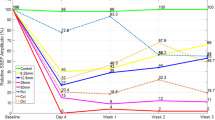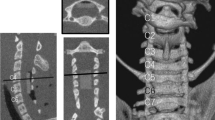Abstract
Study design:
Observational study in rats subjected to traumatic spinal cord injury (SCI).
Objectives:
To describe the features of spinal subarachnoid bleeding (SSB) occurring after graded SCI. SSB after SCI has been reported previously, but has not been studied systematically despite the fact that cerebral subarachnoid bleeding often produces severe neurological damage.
Setting:
Mexico.
Methods:
Anesthetized rats were subjected to mild or severe spinal cord contusion at T9. Occurrence, size, progression and location of SSB were characterized morphologically and scored from T7–T12 at 1 h and 1, 3 and 7 days post injury. Besides, contusions were videotaped to visualize bleeding at the moment of impact.
Results:
SSB started immediately after contusion (severe or mild) and decreased gradually over time. For all vertebral segments, at all time points examined by histology, 48% of areas scored after severe contusion showed bleeding: 25% minor, 17% moderate and 6% major. After mild contusion, only 15% showed bleeding: 13 minor and 2% moderate. Maximum bleeding occurred early after injury in dorsal area of the epicenter in 100% of severe contusions (6% minor, 38 moderate and 56% major), and in 69% of mild contusions (63 minor and 6% moderate).
Conclusion:
Here, we detail SSB patterns occurring after graded SCI. Further studies are warranted to elucidate the possible role extramedullary events, such as SSB, in the pathophysiology of SCI that might encourage the development of new strategies for its management.
Similar content being viewed by others
Log in or create a free account to read this content
Gain free access to this article, as well as selected content from this journal and more on nature.com
or
References
Guizar-Sahagun G, Rodriguez-Balderas CA, Franco-Bourland RE, Martinez-Cruz A, Grijalva I, Ibarra A et al. Lack of neuroprotection with pharmacological pretreatment in a paradigm for anticipated spinal cord lesions. Spinal Cord 2009; 47: 156–160.
Stahel PF, VanderHeiden T, Finn MA . Management strategies for acute spinal cord injury: current options and future perspectives. Curr Opin Crit Care 2012; 18: 651–660.
Yablon IG, Ordia J, Mortara R, Reed J, Spatz E . Acute ascending myelopathy of the spine. Spine (Phila Pa 1976) 1989; 14: 1084–1089.
Koenig G, Dohrmann GJ . Histopathological variability in 'standardised' spinal cord trauma. J Neurol Neurosurg Psychiatry 1977; 40: 1203–1210.
Reyes-Alva HJ, Franco-Bourland RE, Martinez-Cruz A, Grijalva I, Madrazo I, Guizar-Sahagun G . Spatial and temporal morphological changes in the subarachnoid space after graded spinal cord contusion in the rat. J Neurotrauma 2013; 30: 1084–1091.
Schatlo B, Dreier JP, Glasker S, Fathi AR, Moncrief T, Oldfield EH et al. Report of selective cortical infarcts in the primate clot model of vasospasm after subarachnoid hemorrhage. Neurosurgery 2010; 67: 721–728.
Budohoski KP, Czosnyka M, Kirkpatrick PJ, Smielewski P, Steiner LA, Pickard JD . Clinical relevance of cerebral autoregulation following subarachnoid haemorrhage. Nat Rev Neurol 2013; 9: 152–163.
Domenicucci M, Ramieri A, Paolini S, Russo N, Occhiogrosso G, Di Biasi C et al. Spinal subarachnoid hematomas: our experience and literature review. Acta Neurochir (Wien) 2005; 147: 741–750.
Metz GA, Curt A, van de Meent H, Klusman I, Schwab ME, Dietz V . Validation of the weight-drop contusion model in rats: a comparative study of human spinal cord injury. J Neurotrauma 2000; 17: 1–17.
Echigo R, Shimohata N, Karatsu K, Yano F, Kayasuga-Kariya Y, Fujisawa A et al. Trehalose treatment suppresses inflammation, oxidative stress, and vasospasm induced by experimental subarachnoid hemorrhage. J Transl Med 2012; 10: 80.
Greenhalgh AD, Brough D, Robinson EM, Girard S, Rothwell NJ, Allan SM . Interleukin-1 receptor antagonist is beneficial after subarachnoid haemorrhage in rat by blocking haem-driven inflammatory pathology. Dis Model Mech 2012; 5: 823–833.
Kamp MA, Dibue M, Etminan N, Steiger HJ, Schneider T, Hanggi D . Evidence for direct impairment of neuronal function by subarachnoid metabolites following SAH. Acta Neurochir (Wien) 2013; 155: 255–260.
Sabri M, Ai J, Lakovic K, D'Abbondanza J, Ilodigwe D, Macdonald RL . Mechanisms of microthrombi formation after experimental subarachnoid hemorrhage. Neuroscience 2012; 224: 26–37.
Murakami K, Koide M, Dumont TM, Russell SR, Tranmer BI, Wellman GC . Subarachnoid hemorrhage induces gliosis and increased expression of the pro-inflammatory cytokine high mobility group box 1 protein. Transl Stroke Res 2011; 2: 72–79.
Sajanti J, Heikkinen E, Majamaa K . Transient increase in procollagen propeptides in the CSF after subarachnoid hemorrhage. Neurology 2000; 55: 359–363.
Bagley C . Blood in the cerebrospinal fluid: resultant functional and organic alterations in the central nervous system A. Experimental data. Arch Surg 1928; 17: 18–38.
Seki T, Fehlings MG . Mechanistic insights into posttraumatic syringomyelia based on a novel in vivo animal model. Laboratory investigation. J Neurosurg Spine 2008; 8: 365–375.
Gross R, Hamel O, Robert R, Perrouin-Verbe B . Perilesional myeloradiculopathy with tethered cord in post-traumatic spinal cord injury. Spinal Cord 2013; 51: 369–374.
Acknowledgements
We thank Francisco Márquez and Álvaro Corona-Juárez for their technical assistance. Grants were from the Instituto Mexicano del Seguro Social (C2007/037) and the Consejo Nacional de Ciencia y Tecnología (104771 I0110/194/09).
Author information
Authors and Affiliations
Corresponding author
Ethics declarations
Competing interests
The authors declare no conflict of interest.
Additional information
Supplementary Information accompanies this paper on the Spinal Cord website
Rights and permissions
About this article
Cite this article
Reyes-Alva, H., Franco-Bourland, R., Martinez-Cruz, A. et al. Characterization of spinal subarachnoid bleeding associated to graded traumatic spinal cord injury in the rat. Spinal Cord 52 (Suppl 2), S14–S17 (2014). https://doi.org/10.1038/sc.2014.93
Received:
Revised:
Accepted:
Published:
Issue date:
DOI: https://doi.org/10.1038/sc.2014.93



